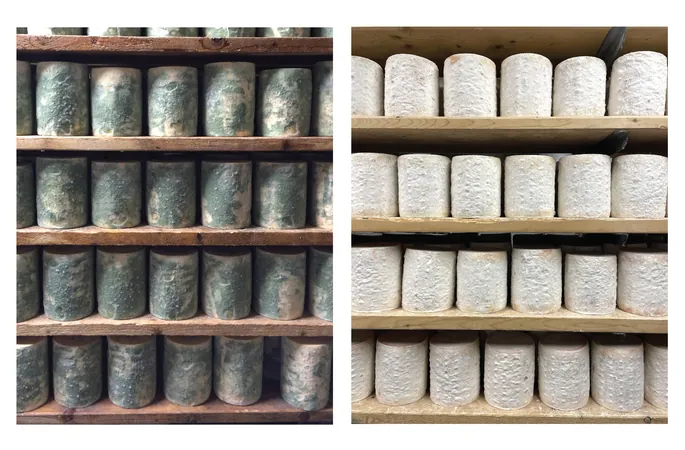
Cheese Cave Evolution: Fungi Unveil Secrets of Rapid Adaptation
2025-09-13
Author: Mei
A Serendipitous Discovery in a Cheese Cave
In the world of science, some of the most groundbreaking discoveries happen by chance. For Benjamin Wolfe, an associate biology professor, a trip to Jasper Hill Farm in Vermont led to an unexpected revelation about evolution—a story that began with a cheese called Bayley Hazen Blue.
In 2016, Wolfe's quest for cheese samples was initially a ploy for romance, as he convinced his former post-doc advisor to drive to the farm under the pretense of a proposal spot. Little did he know, the cheese he stored in his lab’s freezer would become the centerpiece of a remarkable study.
Fungal Evolution Unfolds Before Our Eyes
Fast forward to recent findings: Graduate student Nicolas Louw inspected fresh samples from the same cheese cave and noticed a striking transformation—the once leafy green fungus was now a stark white. This color change sparked excitement in Wolfe’s lab. "We witnessed evolution happening in real-time," Wolfe noted, emphasizing how rare it is to observe microbial evolution in a natural setting.
The Urgency of Understanding Fungal Adaptation
Louw explained that studying how fungi adapt to their environments could have major implications for global food security and health. Shockingly, fungi are responsible for losing around 20% of staple crops before harvest and another 20% after—transforming our fresh produce into rotten remnants.
The Science Behind the Change: A Key Genetic Mutation
As the cheese wheels matured in the caves, they developed microbial rinds from various bacteria, yeast, and molds. The pivotal question emerged: What triggered the transformation in the Penicillium solitum fungi?
The answer lay in a gene called alb1, discovered by student Jackson Larlee during microbiology coursework. Alb1 is crucial for melanin production, which provides protection from UV damage. In the dark cave environment, the fungi could conserve energy by ditching melanin, resulting in the dramatic color shift.
Relaxed Selection: Nature's Energy-Saving Strategy
This phenomenon, known as "relaxed selection," occurs when environmental stresses are alleviated. Similar adaptations have been observed in various creatures, from cave-dwelling fish to certain insects. In this case, it allowed the fungi to thrive by redirecting their energy for growth rather than pigmentation.
A Rich Tapestry of Mutations
What’s fascinating is that the color change in these fungi wasn’t due to a single genetic alteration. Instead, multiple mutations, including point mutations and large DNA insertions by transposable elements, played a role in disrupting alb1’s function—enabling the fungi to skip melanin production.
From Cheese to Health: The Broader Implications
The research isn’t just about cheesy delights. It paves the way for understanding how Aspergillus fungi, often found in household environments, adapt. Identifying these mechanisms could help prevent severe lung infections caused by some strains.
Culinary Innovations from Fungal Evolution
Meanwhile, the Wolfe lab is taking its newfound knowledge and using it to craft experimental cheeses. By inoculating brie with the evolved white mold, they produced a cheese that’s "slightly nuttier and less funky," according to Louw. Sensory panels showed promising results for future recipes.
The Future of Cheesemaking is Bright
As Wolfe remarked, observing wild molds evolve within a few years opens exciting possibilities for cheesemaking innovation, allowing for the development of new flavors and textures through a robust domestication process. This journey from cheese cave fungi to culinary masterpiece exemplifies the interconnectedness of nature, science, and gastronomy.


 Brasil (PT)
Brasil (PT)
 Canada (EN)
Canada (EN)
 Chile (ES)
Chile (ES)
 Česko (CS)
Česko (CS)
 대한민국 (KO)
대한민국 (KO)
 España (ES)
España (ES)
 France (FR)
France (FR)
 Hong Kong (EN)
Hong Kong (EN)
 Italia (IT)
Italia (IT)
 日本 (JA)
日本 (JA)
 Magyarország (HU)
Magyarország (HU)
 Norge (NO)
Norge (NO)
 Polska (PL)
Polska (PL)
 Schweiz (DE)
Schweiz (DE)
 Singapore (EN)
Singapore (EN)
 Sverige (SV)
Sverige (SV)
 Suomi (FI)
Suomi (FI)
 Türkiye (TR)
Türkiye (TR)
 الإمارات العربية المتحدة (AR)
الإمارات العربية المتحدة (AR)